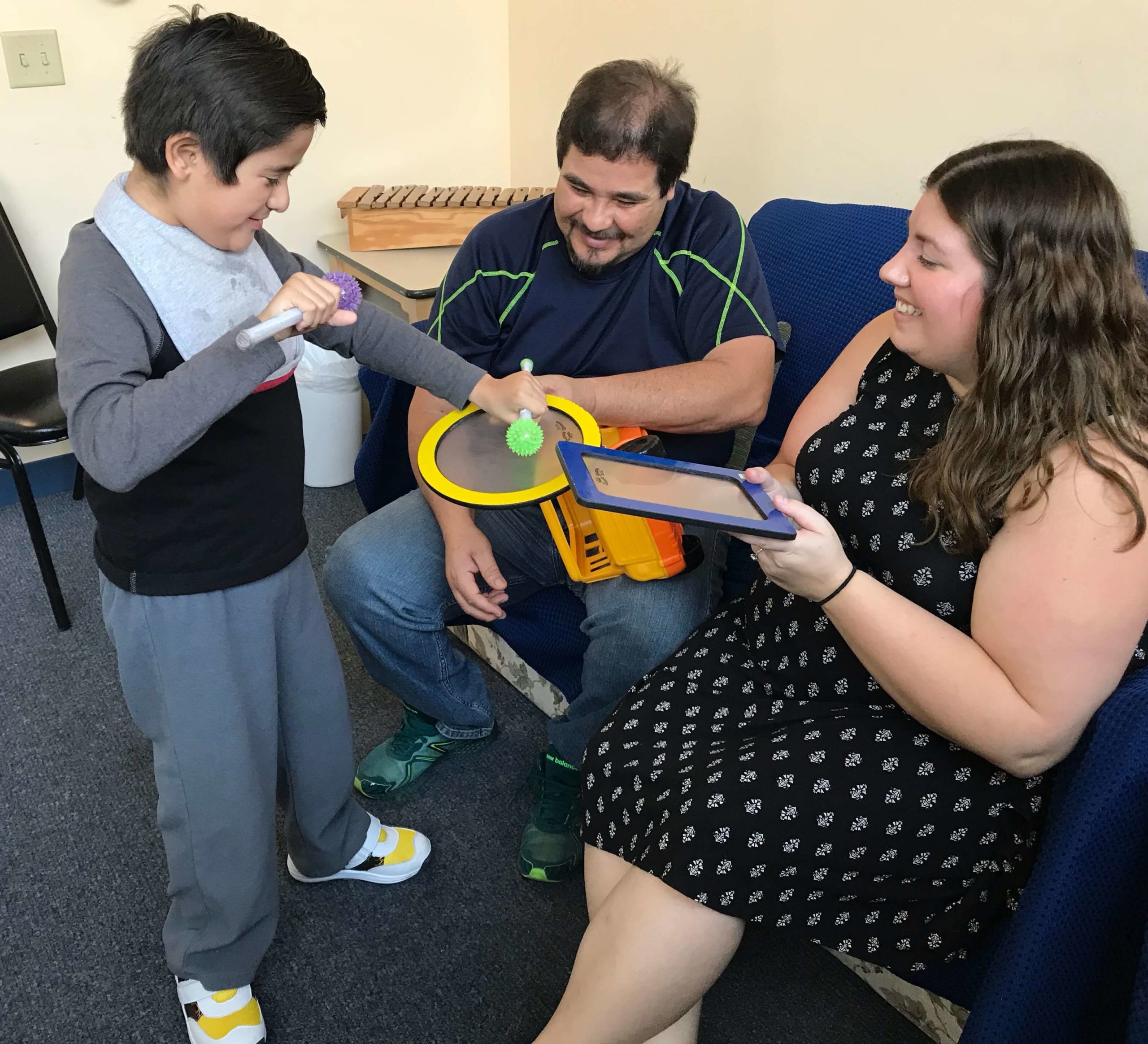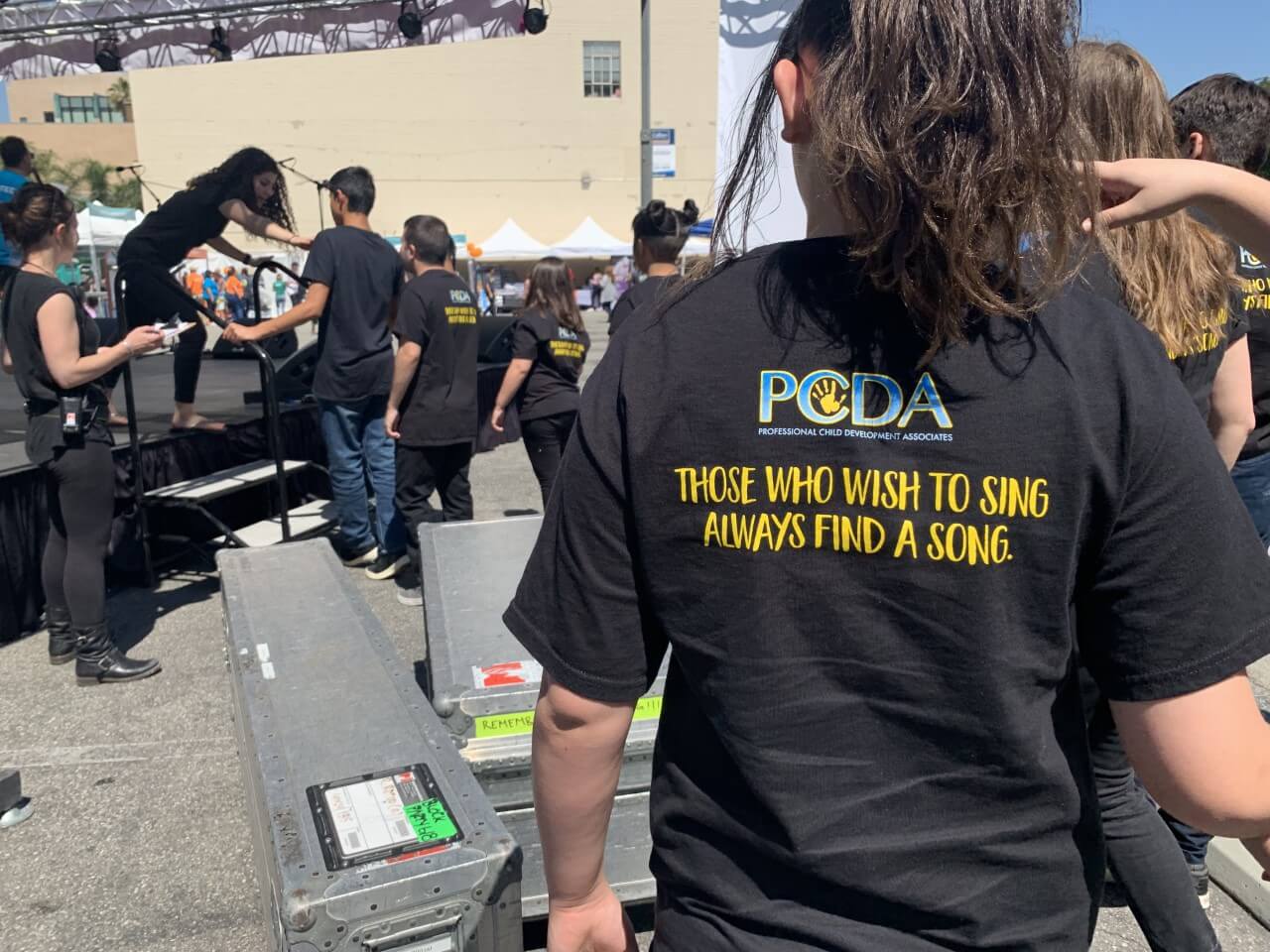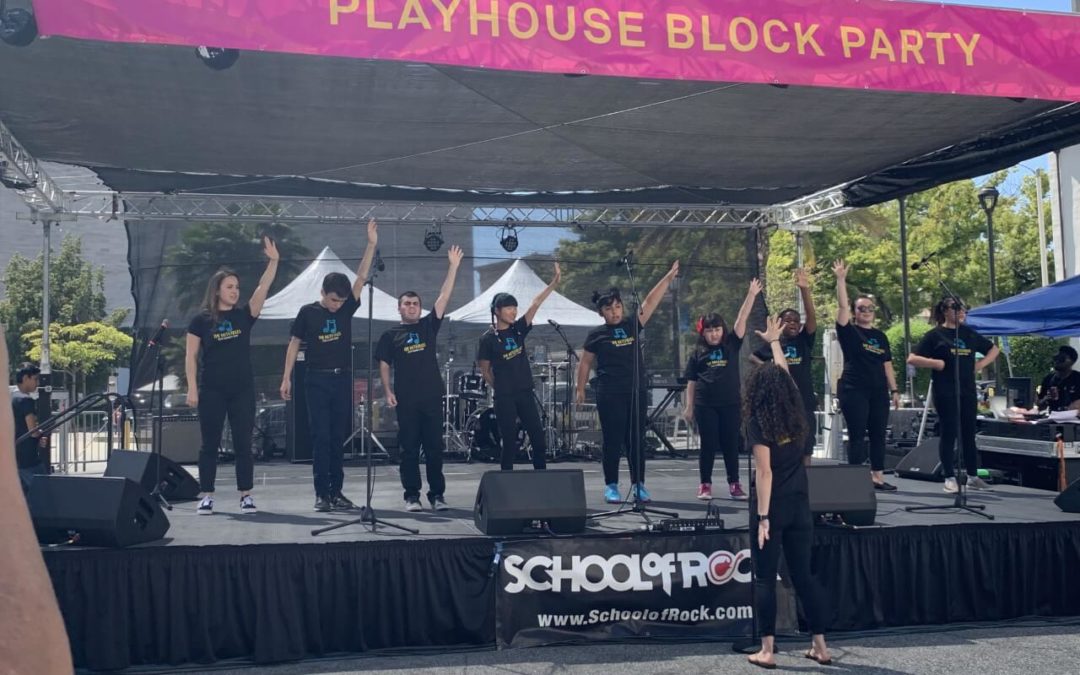Juliana Ross is a Developmental, Individual differences, Relationship-based (DIR) Music Therapist and the Head of the Creative Arts Department at PCDA, Professional Child Development Associates in Pasadena, California. Today we are talking about the unique Creative Arts programs offered at PCDA, including music therapy, where they emphasize working closely with parents and creating many opportunities within their services to foster the parent-child relationship. All of their music therapists are board certified music therapists and have completed their Introduction to DIR and John Carpente’s training on orchestrating affective relationships in musical play through DIR/Floortime in music therapy with children on the autism spectrum.
Creative Arts Through Music and Drama
The Creative Arts Department
PCDA is one of the largest multi-disciplinary clinics providing DIR/Floortime services, serving almost 600 families. Over the past five years they’ve created some wonderful programs including music therapy, adapted music lessons, an adapted children’s choir called the NoteAbles, and a drama program called the Young Actors Squad that’s led by amazing clinicians and teachers who are not only certified in their fields, but who also have experience in extra curricular activities like choir or Improv. On top of that, bringing in DIR/Floortime makes it very unique.
In music therapy, they see babies right through to age 25. They’ve also worked with older adults in homes and special education classrooms K to 12. Most children are on the spectrum, but they also see children with global developmental delays and other disabilities. They try to include all children and families in all that they do. In every music therapy session, they always try to include the parents and family in the session. Although the clinicians are goal-oriented in the areas of social-emotional development, if you were to drop into a session you’d see family’s sitting on the floor with a variety of instruments just having fun playing and singing together.
The Multi-disciplinary Approach
Juliana continues that the best thing about being in a multi-disciplinary clinic is that while you’re in music therapy, you have speech therapy happening down the hall, then the occupational therapy gym or feeding sessions with an occupational therapist. Families are seen by multiple therapists in the Center. It allows for consulting together on a treatment team with the overall DIR umbrella to inform each therapist’s practice. In music, she says, you can see everything come together where you’ll see them use their new words or skills learned in O.T.
The team understands where each child is on the developmental milestones and what their individual differences are as they build relationships. Music therapy here is not a music service that stands alone. The staff have so much experience, many being there for over a decade now. As a music therapist, she figures out how music fits in to the child’s overall treatment and the significance of having music in their lives to engage them. It’s the affect and the fun for Juliana. Music therapy and affect are one and the same to her. It helps identify all ranges of emotion for children.
How you can interpret that in music is magical because you don’t need words to express them. If she plays a dissident chord, the child can feel that. If they’re struggling with trying to open a toy, for instance, she can express that frustration through music even if they can’t express that frustration with words. The child can think, “Oh, that’s what that feeling is and I can call it ‘this’ word“. Music is such a bridge for all the services the child receives, she explains.
I echoed how this idea of a multi-disciplinary approach is exactly what Engaging Autism describes and that it’s so much more convenient for autistic kids to come to one building that is familiar to see practitioners whom they have a Relationship with and who understand where they are Developmentally levels and Individual profiles, and who all co-ordinate their services together in the child’s best interest for a holistic program for the family. I also commented on the music group setting where they’re not only doing music but Floortime in a small group.
Family Dynamics
Juliana says they love when families come in, including siblings, where you can see the family dynamics happening. It provides so much information on how that child interacts because these are the people the child interacts with all the time, she continues. One of the great advantages she has as a music therapist is how to lead groups. It’s not always easy to meet everyone where they’re at–especially when siblings don’t want to do something in particular–but when you’re facilitating a music group, you learn how to incorporate everyone’s ideas and create a cohesive group goal.
In terms of DIR, how do you create shared attention and engagement? You have to start with if everyone is motivated and interested, and everything builds after that. You always start with a hello song, introductions, then provide an activity for everyone to do together, incorporating movement, always looking to see if everyone’s participating. She tells the parents that their voice is the one the kids relate to the most–even if they’re not a good singer. It’s about creating shared moments together so you feel comfortable using your voice and using music together to empower them to be able to do this at home. She’s heard from parents that they put on music and dance around the living room. You should have permission to do that during the week as many times as you like, Juliana exclaims.

The Focus on Shared Joyful, Affective Interactions
I reminded the listener that music therapy is not music lessons. It’s not about teaching musical skills. It’s about creating moments of shared joy between family members through the use of music. It’s about the affective experience together. I shared how my son and I listen to PJ Masks and Mario Kart songs and he likes to replace the names of the PJ Masks characters in those songs with Mario Kart character names. He might sing off time or out of key, but we are having a joyful emotional experience together that he really enjoys as do I. This is Floortime.
Using Music for Transitions
Your child doesn’t have to be interested in music to benefit from music therapy, Juliana says. Music is like a shared language that has that ability to connect us instantly. It’s multi-sensory as we listen to the same thing. The heart rates and breathing of those in drumming groups synchs together over time, according to research, so it can provide benefits beyond one-on-one therapy. You can take a song like ‘Twinkle, twinkle little star‘ and make it about going to the potty or putting on shoes which can become a transition song. At my son’s nursery school they used songs for every transition and it definitely helped my son and the kids with transitions.
Anticipation and predictability helps with engagement, too, Juliana explains because when kids know what’s coming next they can feel more prepared for that interaction. While it is a bit structured to sing a song every time you have a specific transition, you can change up the affect, she continues, or make it go faster or slower. You can be quieter to indicate a more calming experience. You can really manipulate the singing. We do this when we communicate with people all the time. We often match another’s posture or energy when we interact with them. Here, we’re following the child’s lead but in music, and take them to where we want the group to go.
Cue Reading for Parents
At the start of a session, Juliana says she might start by being energetic because of the tension the children may be feeling, but then she’ll slow it down, and maybe follow it up with a slower song. She’ll do this slowly to follow the pacing of the children who need it to be done slowly. She’ll read their affective and postural cues to meet them where they are at. Then she’ll point these kinds of thing out to the parents. “Oh, look, Mom, how he’s facing you now. Look how his shoulders are down now.” She tries to pinpoint all of these nuanced cues so the parent can be more aware to be the leader in the session for practice at home.

Adapted Music Lessons and Choir
PCDA also offers adapted music lessons. Having a child with a disability may make families feel like their child can’t join a typical choir or other musical group or art class, but adapted lessons are for children to be able to learn an instrument with a trained therapist, but in an adaptive way. Your child might be interested in the piano, but can’t sit for 30 minutes at the piano. They incorporate different strategies such as teaching rhythm using a drum while marching around the room or using a mallet to play eighth notes. It doesn’t look like your typical music lesson.
Your child might be able to play a 3- or 5-minute piece at their recital. They have no-pressure recitals where parents are allowed to be a part of the performance if required, and they have a sensory space where kids can go to if they need it. The trained music therapist tailors the lessons to the child’s individual needs. Choir also focuses on musical skills in an adapted way. Dr. Diane Cullinane was asked to put together a group of children for a performance at the Rose Bowl so they decided to start a choir.
A group of about 10 of different ages and abilities started to practice the Star-Spangled Banner. Even the non-speaking kids participated by humming along or waving the flag. It was very successful and they did it three years in a row. Many of the children were discouraged from joining other similar groups at their school or they didn’t have the individual support required. The staff realized they had to keep this alive, so out of this 4th of July celebration, the NoteAbles children’s choir was formed. It’s a performance group. They’ve been a part of the community performing at the Eclectic Music Festival, the Pasadena Playhouse Block Party, and performed at the fundraisers for PCDA.
Juliana says that if you’ve ever been a part of band or a performance, you know what a rewarding experience it can be performing for people or for your family, or for them to see you on stage and clap. Even through Telehealth they are leading the choir through the pandemic. They have been learning dance routines and have shown such growth from the start of the group. They also get a great turnout from the PCDA staff who get to see their clients in a different context.
Drama Group
The drama group at PCDA is called The Young Actors Squad, a group of teens who named their own group. It is led by Kristen Williams who brings to the group her Improv training and her Marriage and Family Counselling background. She has an incredible way of communicating with the team. The head of Speech and Language, Anne Davis, co-leads the group who brings an amazing perspective because improv is about communicating. The group takes what a traditional improv class would provide (i.e., sketch-like comedy) but breaks it down into the more simple concept of “Yes, and…“. You always have to follow what the other person says. This is a way to connect and build bridges on symbolic ideas.
The Importance of Creative Arts Offerings
Juliana says their team does a lot of fundraising and grant writing to make these programs possible. She credits Dr. Diane Cullinane for having the vision to create the clinic with all of these programs. Besides Creative Arts, they also have a feeding clinic for picky eaters, Occupational Therapy, Speech and Language Therapy, early intervention services, early intervention services, and teen club services. A child could start in the clinic and spend 18 years of life getting services in one place which forms the relationship with the agency and clinicians which builds trust for families and kids alike.
I expressed my dream of seeing a clinic like this in Toronto instead of the behaviourally-based clinics we have. Dr. Joshua Feder and I did discuss the move towards developmental approaches and PCDA is surely a fantastic example of what every city could offer: providing so many rewarding types of therapies including the creative arts services, having all disciplines housed under one DIR/Floortime umbrella in one location, and bringing in families and including families in the approach since Floortime is parent-mediated.
The Importance of Feeling Included
I commented how wonderful it is to have programs where parents and children can feel comfortable without the scrutiny of other families. Juliana said it’s their goal to make families feel welcome and included. The pandemic showed the practitioners how much they had a relationship with families and the process of listening to everyone over the computer strengthened those relationships. It’s also the perfect modality to coach since the practitioners can’t be hands-on and there. I took that opportunity to plug the DIR Home Program which is a virtual coaching program, and many DIR providers offer this service as well.
All of the equipment was at PCDA so they had to get creative with the parents to use movement and song. It teaches the parent to be creative without needing toys. What makes parents the most exciting toy, Juliana explains, is the use of affect–the range in the use of your body and voice. It connects so well with music, she says.
Check out some of these podcasts
This week's PRACTICE TIP:
This week try to facilitate some joyful circles of communication with your child around music.
For example: March around the room to a beat, use something as an instrument to keep a beat, sing a song your child likes while using something as a drumstick to keep the beat, or whatever you can think of that will create opportunities for interaction and fun!
Thank you to music therapist, Juliana Ross, for sharing these incredible services that PCDA offers. If you enjoyed and found it useful and helpful, please do share it on Facebook or Twitter and feel free to share relevant experiences, questions, or comments in the Comments section below. Also stay tuned for parts 2 and 3 in the next podcasts where we’ll hear more about the variety of services offered at PCDA. Whether you’re in the area, or interested in similar services in your area, you’ll learn a lot about the variety of Floortime services available!
Until next week, here’s to affecting autism through playful interactions!




I really enjoyed this podcast. My son thrives on music. I absolutely agree that it is challenging for some children with ASD to be included in a mainstream choir. My son has been included in a mainstream choir for approximately four years. He is only at the emergent level of reading and the teacher provides the children sheet music. An accommodation is that I take the title of the song and the composer and 99% of the time I can find that someone has uploaded the song to YouTube. During the week I have him practice the various songs so that not only can he be included, but he can be successful and thrive in the group. I only mention this because it has worked so beautifully for our family. I totally agree that if a child with exceptionalities is included in more of a mainstream population that various supports and accommodations are probably needed for the experience to be joyful for the child.
Our son also attends group music therapy with other children with exceptionalities and enjoys that as well. Thanks again for this podcast and others as well.
Thank you, Jacqueline! Wonderful to hear.